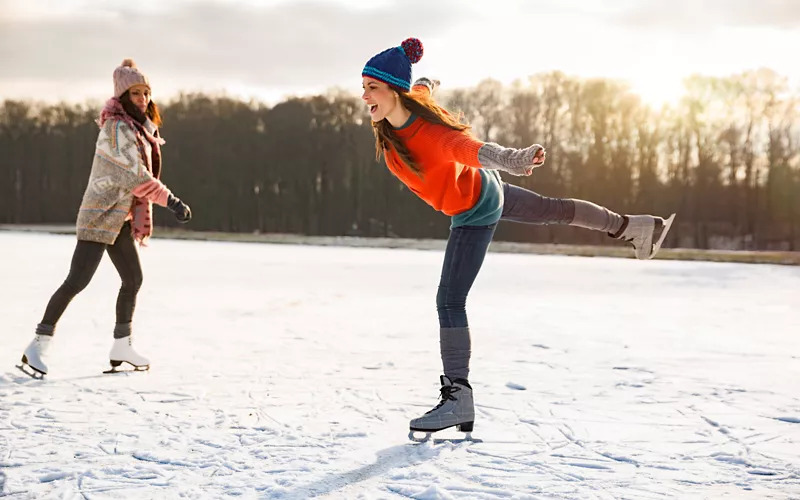
Ice skating isn't a year-round sport for many people, but few winter activities seem to go better with the colder weather. Even so, putting on skates might be scary if you don't know what you're doing, especially if you're an adult.
Gaining new abilities to improve your off-ice fitness, on-ice form, and general mentality can help you enjoy the thrill of sliding across frozen surfaces and keep you in shape for other activities if you feel more unsteady than graceful.
Competitive figure skater Kelly Cassity, who is currently the Utah Olympic Oval's coordinator of Learn to Skate, claims that ice skating is a full-body workout. Balancing on a 4-millimeter-thick blade necessitates coordination, resolve, and balance.
She goes on to say that the largest error adults make when they first go onto the ice is to tighten up out of anxiousness. As a result, falls hurt considerably more since your strained muscles can't absorb the impact as well. You'll go far if you keep your knees bent, stay close to the ice, and develop your ability to fall and get back up.
Before practicing edging, crossovers, and other drills on the ice, skaters can strengthen their core muscles and balance off the ice.
It will be worthwhile to master these principles, claims Cassity. "When you take on a challenging task, you feel proud and satisfied with yourself. Additionally, skating is a terrific opportunity to connect with other adults as it can be a very social sport.
According to former college hockey player Andy Ness, who is currently the coach at ProEdge Power in Minnesota and the skating and skill coach for the Minnesota Wild, skating is also a great technique to build endurance.
These easy exercises and advice from Cassity and Ness will help recreational skaters have fun on the rink.
Beginner Ice Skating Drills and Technique Tips
Drill 1: Stretching
According to Cassity, having lean muscles allows for more fluid motions on the ice as well as fewer falls. These are some lower-body stretches that she suggests doing as part of your training at home. Practice these movements each day after a brief vigorous warm-up like jumping jacks or jogging.
Hamstring Stretches in Supine: With both legs extended straight, lie on your back. Raise one leg and support yourself with your ankle, calf, or rear thigh. Draw your elevated leg toward your head while maintaining full range of motion in both legs to feel a stretch in your hamstrings; avoid pulling until you experience discomfort. For extra support, wrap a towel or resistance band around your foot. Hold each leg for a duration of one to two minutes.
To perform a hip-flexor stretch, place your feet three to four feet apart in front of your back. Bend the front knee directly over the toes and lift the rear heel while maintaining a braced core and hands on hips. As you descend, maintain your front shin vertical and your chest raised. A stretch at the front of that hip can be felt by straightening the back leg and contracting your glutes. Hold each side for thirty seconds.
Drill 2: Balance
Ness adds that this technique develops the muscle and balance required to stay upright on the ice. Include this three-part exercise in your program three times a week.
Place your feet hip-distance apart and stand on the curved side of a BOSU ball. Bend your elbows and squat with your hands facing front and your palms facing up. While keeping your squat, rotate your head and torso in the same direction by moving your hands left and right. In each direction, repeat ten times.
Elevate your right foot and tap it to the right side of the floor while standing on the BOSU ball. Repeat with the left leg after you've returned to the center. Perform 20 repetitions on alternate sides.
Stretch your left leg out behind you two to three feet, keeping your heel raised and your left toes on the floor, while keeping your right foot on the BOSU ball. Lean forward to execute a lunge. After ten repetitions, switch to the opposite side.
Drill 3: Falling and Getting Up
According to Cassity, knowing how to fall safely will assist keep you safe in the event that you take an unplanned crash. Landing on a more muscular area rather than your hands is crucial. Start by working on your technique off the ice, both with and without skates. Proceed to the ice and descend first at a slower pace, then at a faster pace while skating.
Put your hands in front of you, bend your knees slightly, and squat while wearing gloves and wrist protection.
Drop to one side, absorbing most of the force on your hips, upper arm, or butt.
Use your hands to adjust your position on all fours in order to stand back up.
Put one foot in front of the other between your hands.
Maintaining a tense gluteal region and bent knees for support, slowly stand up.
Drill 4: Edging
According to Ness, improving your balance and blade strength will help you become more confident when skating. Start each rink session with this drill as soon as you can skate steadily.
Skate in a clockwise direction around the rink. After three strides, pivot on one leg in a small circle while concentrating on maintaining your outside edge balance.
Continue skating ahead for three more strides before switching to the other leg. Recall to keep your hips down, knees bent, and body low to the ice.
As you progressively gain strength and endurance, switch legs and make five trips up and down the ice.
Comments (0)